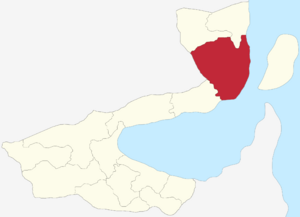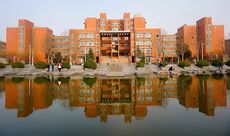Difference between revisions of "Meixian"
(Created page with "{{Infobox settlement | name = Meixian | official_name = | other_name = Méixiàn zhōu | native_name = 梅縣州 | s...") |
m |
||
| Line 43: | Line 43: | ||
'''Meixian''' ([[Monsilvan language|Monsilvan]]: 梅縣州; [[Pinyin]]: ''Méixiàn zhōu''), is a [[Administrative divisions of Monsilva|state]] of the [[Monsilvan Republic]]. The state has around 5.6 million people, with 71% of them living in the state's capital, [[Menchi]]. It is located in northern Monsilva, sitting south of [[Leibo]] and [[Luhai (state)|Luhai]], north of [[Maguan]] and east of the nation of [[Akvarelusus]]. Meixian is a large state, with a climate that ranges from warm and flat coastal regions to the mountainous, cooler regions of the west. The state of Meixian is governed by the [[Meixian State Government]], with [[Tsang Ju]] of the [[Freedom and Democracy Party (Monsilva)|FDP]] being the current state minister. The state is divided into 8 districts, 28 counties and 71 municipalities and is equally represented by 8 [[Member of the Senate (Monsilva)|Senators]] in the [[Senate of Monsilva|Senate]] and 28 [[Member of the Legislative Assembly (Monsilva)|members]] in the [[Legislative Assembly of Monsilva|Legislative Assembly]]. The [[Meixian State Government|Meixian State Parliament]] consists of 71 seats, and is currently lead by the FDP, with the [[Reformed National Party (Monsilva)|RNP]]/[[People's New Party (Monsilva)|PNP]] coalition leading the opposition. | '''Meixian''' ([[Monsilvan language|Monsilvan]]: 梅縣州; [[Pinyin]]: ''Méixiàn zhōu''), is a [[Administrative divisions of Monsilva|state]] of the [[Monsilvan Republic]]. The state has around 5.6 million people, with 71% of them living in the state's capital, [[Menchi]]. It is located in northern Monsilva, sitting south of [[Leibo]] and [[Luhai (state)|Luhai]], north of [[Maguan]] and east of the nation of [[Akvarelusus]]. Meixian is a large state, with a climate that ranges from warm and flat coastal regions to the mountainous, cooler regions of the west. The state of Meixian is governed by the [[Meixian State Government]], with [[Tsang Ju]] of the [[Freedom and Democracy Party (Monsilva)|FDP]] being the current state minister. The state is divided into 8 districts, 28 counties and 71 municipalities and is equally represented by 8 [[Member of the Senate (Monsilva)|Senators]] in the [[Senate of Monsilva|Senate]] and 28 [[Member of the Legislative Assembly (Monsilva)|members]] in the [[Legislative Assembly of Monsilva|Legislative Assembly]]. The [[Meixian State Government|Meixian State Parliament]] consists of 71 seats, and is currently lead by the FDP, with the [[Reformed National Party (Monsilva)|RNP]]/[[People's New Party (Monsilva)|PNP]] coalition leading the opposition. | ||
| − | Meixian is Monsilva's third most populous state, but has only the seventh highest urbanization of all the states. In terms of industry, rural Meixian produces a wide range of medicinal products, animal products, cocoa, coffee, fruits such as plums and oranges, tea and fish. Agriculture industry is massive in Meixian due to its large rural area, this is clear even within the city of [[Menchi]], where many large office buildings are full of agricultural businesses. [[Taoyuan]] is | + | Meixian is Monsilva's third most populous state, but has only the seventh highest urbanization of all the states. In terms of industry, rural Meixian produces a wide range of medicinal products, animal products, cocoa, coffee, fruits such as plums and oranges, tea and fish. Agriculture industry is massive in Meixian due to its large rural area, this is clear even within the city of [[Menchi]], where many large office buildings are full of agricultural businesses. [[Taoyuan]] is Meixian's only city other than the capital and has a population of just over 558k people. Taoyuan is located in the south of Meixian, next to the border with [[Maguan]]. Taoyuan is a mostly residential city, with the city centre being relatively small and mostly focusing on commercial industry. Meixian has a nominal GRP of around ₵171 billion, giving it a GRP per capita of ₵30,513. |
Meixian is served by the [[Monsilvan Railways Administration]] which connects the state to the rest of Monsilva, it is also served by the [[Federal North Railway]] which serves many stations in Meixian, especially in the west as well as servicing [[Luhai (state)|Luhai]] and [[Leibo]]. Menchi has the [[Menchi Metro]] which serves all of greater Menchi City. Meixian has one international airport: [[Menchi Qianzhen International Airport]]. The Monsilvan high-speed rail service serves Menchi Central, Menchi South and Taoyuan. The high-speed runs to cities such as [[Amking]], [[Waiping]], [[Maojie]] and [[Luhai]]. | Meixian is served by the [[Monsilvan Railways Administration]] which connects the state to the rest of Monsilva, it is also served by the [[Federal North Railway]] which serves many stations in Meixian, especially in the west as well as servicing [[Luhai (state)|Luhai]] and [[Leibo]]. Menchi has the [[Menchi Metro]] which serves all of greater Menchi City. Meixian has one international airport: [[Menchi Qianzhen International Airport]]. The Monsilvan high-speed rail service serves Menchi Central, Menchi South and Taoyuan. The high-speed runs to cities such as [[Amking]], [[Waiping]], [[Maojie]] and [[Luhai]]. | ||
Revision as of 18:50, 24 January 2023
Meixian 梅縣州 Méixiàn zhōu | |
|---|---|
 Map of Monsilva with Meixian highlighted | |
| Country | |
| State status | 3 June 1983 |
| Capital | Menchi (門池) |
| Government | |
| • Body | Meixian State Government |
| • State Minister | Tsang Ju (FDP) |
| • Deputy State Minister | Xiao Huang (FDP) |
| Population (July 2022) | |
| • Total | 5,594,884 |
| Time zone | AMT-12 (Monsilvan Standard Time, MST) |
| ISO 3166 code | MS-MEI |
| GRP (M¥) | M¥1.03 trillion |
| Major airports | Menchi Qianzhen International Airport (MQI) |
| Transit System(s) | MRA Federal North Railway Menchi Metro |
| Police[1] | Meixian State Police |
| Ambulance[2] | Meixian State Ambulance |
| Fire[3] | Meixian Fire Service |
Meixian (Monsilvan: 梅縣州; Pinyin: Méixiàn zhōu), is a state of the Monsilvan Republic. The state has around 5.6 million people, with 71% of them living in the state's capital, Menchi. It is located in northern Monsilva, sitting south of Leibo and Luhai, north of Maguan and east of the nation of Akvarelusus. Meixian is a large state, with a climate that ranges from warm and flat coastal regions to the mountainous, cooler regions of the west. The state of Meixian is governed by the Meixian State Government, with Tsang Ju of the FDP being the current state minister. The state is divided into 8 districts, 28 counties and 71 municipalities and is equally represented by 8 Senators in the Senate and 28 members in the Legislative Assembly. The Meixian State Parliament consists of 71 seats, and is currently lead by the FDP, with the RNP/PNP coalition leading the opposition.
Meixian is Monsilva's third most populous state, but has only the seventh highest urbanization of all the states. In terms of industry, rural Meixian produces a wide range of medicinal products, animal products, cocoa, coffee, fruits such as plums and oranges, tea and fish. Agriculture industry is massive in Meixian due to its large rural area, this is clear even within the city of Menchi, where many large office buildings are full of agricultural businesses. Taoyuan is Meixian's only city other than the capital and has a population of just over 558k people. Taoyuan is located in the south of Meixian, next to the border with Maguan. Taoyuan is a mostly residential city, with the city centre being relatively small and mostly focusing on commercial industry. Meixian has a nominal GRP of around ₵171 billion, giving it a GRP per capita of ₵30,513.
Meixian is served by the Monsilvan Railways Administration which connects the state to the rest of Monsilva, it is also served by the Federal North Railway which serves many stations in Meixian, especially in the west as well as servicing Luhai and Leibo. Menchi has the Menchi Metro which serves all of greater Menchi City. Meixian has one international airport: Menchi Qianzhen International Airport. The Monsilvan high-speed rail service serves Menchi Central, Menchi South and Taoyuan. The high-speed runs to cities such as Amking, Waiping, Maojie and Luhai.
Contents
Toponymy
The name, Meixian comes directly from the HY Pinyin of the Monsilvan "梅縣". The character "梅" means "plum" in Monsilvan, and the character "縣" means "region". Therefore, Meixian directly translates to "plum region", which is likely due to the large plum cultivating industry in the region.
History
Prehistory and early dynasties
Meixian was the largest region of the Qin dynasty during its existence from the early 8th century BCE to 1201 CE. The entire region of Meixian had a wide range of uses for the dynasty, with a significant amount of agriculture done in the west, whilst the east were full of large trading settlements. Menchi and Taoyuan were important settlements for the Qin dynasty, but their proximity to the Tang dynasty worried the emperor, which caused the erection of the Meixian Wall, which extends across the border between Maguan and Meixian today.
After the Qing dynasty invaded the Tang dynasty in 650 CE, Meixian recieved a large influx of former Tang dynasty people who were fleeing their burning towns. The pressure of agriculture in Meixian was also lifted, as the newly aquired land from the Tang dynasty allowed the Qin to spread their agricultural industry out.
Zhou dynasty and the Empire of Baltanla
When the Unification of the Monsilvan Kingdoms took place in 1201, the Qin dynasty was disbanded and replaced with the Zhou dynasty, which ruled over all of modern-day Monsilva. Meixian gradually grew in population over the years thanks to its thriving agricultural industry that was attractive to travellers and traders across the nation.
The Zhou dynasty's government started to become weakened by thriving businesses in Meixian, which were able to manipulate the emperor with their vast amount of agricultural production. This became a serious issue during the later years of the dynasty, as the agricultural industry began decreasing massively in Meixian for unknown reasons, that are still being determined by historians. Either way, the Zhou dynasty began to suffer, and made efforts to use Maguan along with other smaller agricultural regions across the dynasty to provide for the nation.
The Zhou dynasty failed, and voluntarily ceded itself to the Empire of Baltanla, which restored Meixian's agriculture sector by killing most of the corrupt people that were formerly running it. This helped Monsilva restore its economy and created a population burst in Meixian.
Kingdom of Great Shan and the Civil War
When Monsilva left the empire in 1730, Meixian had become a behemoth of an agricultural region, with thousands of people working in fields all across the region. Meixian quickly became on of the most populated regions during the Kingdom of Great Shan, and was one of the country's most important regions. Meixian sustained its industry throughout the 17th and 18th centuries successfully.
When the Monsilvan Civil War arrived in 1824, Meixian was the first to hear of the war, as troops from the Liberate Monsilva Movement, which had already occupied Luhai before the war formally began, moved through the state towards the border with Maguan, which had sided with the Imperial Government. Most of Meixian was untouched by the war, as most of it took place beyond Maguan. However, the areas around the city of Taoyuan were not as lucky, and suffered from military bombardment and fires.
Kingdom of Monsilva and the Republic
Meixian was a vital region just after the war, as it had the only fully developed agricultural industry still standing after the war. Fortunately, due to the immense size, it was plenty to aid the hundreds of thousands who were in need of food, water and other amenities.
During Martial law in Monsilva, Meixian was relatively unaffected until the early 1970s, when protests began to occassionally erupt in Menchi and Taoyuan. This lead to increased police presence which also increased the amount of brutality against non-Monsilvans as well as people who broke the strict laws. In 1978, Menchi and Taoyuan were some of the many cities which took part in the 1978 Monsilvan protests, which lead to the eventual dissolution of the Kingdom of Monsilva government and the establishment of the Republic by the Monsilvan Revolutionary Army.
Meixian had been a region during both the Kingdom of Monsilva and Great Shan, so when the Monsilvan Republic was established in 1978, Meixian immediately became a state, although devolved powers did not come to any states until later. When Meixian was given devolved power in 1983, the Meixian State Government was established, succeeding the Meixian Advisory Council. The Meixian State Government has been governed by the FDP since its establishment.
Administration
Local government
The state of Meixian is governed by the Meixian State Government, based in the Meixian State Office in Menchi. The state government is a unicameral legislature consisting of a 71-seat State Parliament. Each municipality in Maguan is represented by one State Parliament Member. Members are elected for for two-year terms. The Parliament meets every week, with the day depending on the first weekday after the State Parliament elections which take place simultaneously across Monsilva every two years. The leading party in the State Parliament determines who will be the State Minister. Tsang Ju of the FDP has been the Meixian State Minister since 2012.
National government
Meixian is represented in the Parliament of Monsilva by 8 Senators in the Senate of Monsilva and 28 Members of the Legislative Assembly. As of the 2020 federal election, Meixian is represented in the Legislative Assembly by 13 RNP members, 12 FDP members and 3 Liberal Party members. Meixian is represented by 4 FDP senators and 3 RNP senators and 1 Liberal senator since the 2020 senate election.
Geography
Meixian's terrain ranges massively, from mountains and valleys in the north-west, whilst the south west has hills, fields and pastures. The east is flatter and near the coast it is much warmer than the rest of the state, and beaches are scattered all along the coast.
Meixian's north-west is well known for being considered one of the most beautiful parts of Monsilva, with large national parks such as Hualien Gorge and the Giant Panda National Park, the only home of the Giant Panda which is endemic to the national park, as well as being the largest national park in the country.
Meixian is one of Monsilva's 9 states with external EEWSs. Earthquakes are occasional in Meixian, and can range from minor tremors to serious earthquakes such as the 2011 Maojie earthquake, which was a 7.3 ML earthquake affecting Maguan and southern Meixian that resulted in 1,800 deaths and around 10,000 injuries as well as ₵150 million in damages. Which is the most deaths from a natural disaster in modern Monsilvan history.
Climate
Meixian can get very cold, and very hot depending on where you are in the state. Meixian's west is much cooler, and is the only part of the state that regularly recieves snow thanks to its high altitude. While the east of the state, along the coast, is much warmer and sunnier and has temperatures that can reach up to 30 degrees. The last typhoon in Meixian was the 2017 Monsilvan typhoon, which resulted in no deaths or serious injuries, but caused around M¥1,206,000 in damages.
Demography
| Country of Birth | Population | Percent | |
|---|---|---|---|
| 5,079,595 | 90.79 | ||
| Non-Monsilvan | 515,289 | 9.21 | |
| 23x15px Fujikuni | 335,693 | 6.00 | |
| 67,138 | 1.20 | ||
| Others | 112,457 | 2.01 | |
| Total | 5,594,884 | 100.0 | |
The 2022 census recorded that 515,289 people or 9.21% of Meixian's population were foreign-born. The table to the right shows the most common countries of birth of Meixian residents. Meixian is very large and has a large population, both rural and urban. 81% of Meixian's population live in cities, being either Menchi or Taoyuan, which is also where the vast majority of Meixian's foreign-born population lives. The other 19% makes up Monsilva's largest rural population by state, with 1,063,028 people living outside of cities.
Religion
Meixian has a majority Monsilvan folk religion population, whilist Buddhism comes in second. Around 67.5% of Meixian's population follow the Monsilvan folk religion to some extent. This is likely due to the deep historical connection between the people of Meixian and the religion, as Meixian is home to many Confucian and Taoist temples which families have been visiting regularly for hundreds of years. Some historians even theorise that the people living in Meixian were some of the first people to ever follow Confucius as a spiritual leader.
Also, as rural populations face less religious opposition due to lower immigrant populations, they are less likely to convert, as their entire lifestyle may revolve around the beliefs that originate from Monsilvan folk religion. Many families would look down upon members that choose to disrespect their family traditions that have lasted for many decades, if not hundreds of years.
Following Monsilvan folk religion in the census was Buddhism at 15.4% of the population; then it was the 'Unaffiliated' category (people who do not follow any organized religion, including atheism and agnosticism) at 13.6%; and finally 'Other' (which includes Christianity and Islam) took up the last 3.5%.
Transport
Meixian's transport is administered by the state's Department for Transport, which is a sub-department of the federal Department of Transport. Meixian struggled with rail access for many years, before the introduction of the Federal North Railway, as the Monsilvan Railways Administration was not planning on serving the west of Menchi, which is where a large portion of the population lives. However, when the FNR was established in 1984, that portion of Meixian was the focus for the new railway company. In 1991, the first section of the railway had been completed, and a huge portion of Meixian now had railway access.
Nowadays, Meixian is one of the most accessible states by rail transport, with 16 stations served by the MRA, as well as 3 stations having high-speed rail services around the country, as well as the Three Peaks Railways route stopping at Menchi South station.
Education
Education is mandatory until the age of 18 for children living in Meixian, which is two years above the minimum age at the federal level (16). Meixian's towns and cities feature many schools, from elementary to high school. As well as this, Meixian is home to many higher education institutes including:
The University of Menchi (UMI) is the top university in the state. It is renowned for its courses in geography, geology and other earth sciences. UMI also has one of the largest university enrollments, with almost 400,000 graduates and undergraduates enrolled in Autumn 2021.
The University of Law, Zhukeng, is the only university in Monsilva that specialises only in law. It is highly regarded for its law courses, and is usually the alma mater of many judges in the Monsilvan courts system, including the Supreme Court of Monsilva and the Federal Constitutional Court of Monsilva.
Culture
Tourism
Meixian is home to a large number of national parks and heritage sites which can be found all across the state. Some of the most famous attractions in Meixian include: Mount Pu, Zuoying Town, East Lake Nature Reserve, Hualien Gorge, National Museum of History and Qingguo Temple.
Unlike many states, most tourists visiting Meixian do not travel for the capital and instead visit the state for the attractions in the rural areas of the state. This makes sense, as most of Meixian's popular sites aren't in the cities.
Sport
Meixian is the least sport oriented state in the country, according to a survey asking the population "Does sport have any impact on your daily life?", in which Meixian was the state with the lowest percentage of "Yes" responses. The reason for this isn't exactly known, but it may be due to Meixian teams being less successful than teams from other states, or possibly due to a lack of sport infrastructure.
However, the most popular sport in Meixian is football, and the state does have two semi-professional football teams, Menchi City F.C. and Taoyuan F.C.. Only Taoyuan F.C. has ever made it into the Challenge League 1, and neither have ever reached the Premier League.






